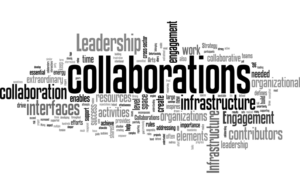Collaborations can be powerful and often essential tools when addressing complex issues. Unfortunately, many collaborative efforts achieve only limited success and some are ineffective. Many attempts at collaboration have instead painfully drained the precious time and leadership focus nonprofits cannot afford to waste. The situation is similar whether addressing new challenges across multiple teams within an organization, developing new collaborations between organizations, or building large cross-sector collaborations. Only a few collaborations achieve extraordinary results, others create tension and frustration that drive participants deeper into their own silos.
At Strategy Arts, our work with hundreds of organizations through the years has helped us refine our understanding of what makes organizational collaborations work and of the importance of strong and well-defined interfaces to their success. We previously used the term organizational intersections when we talked about collaborations, but realized that collaborations are much more. They are more intentional. They are spaces with different but interrelated rules, activities, and resources drawn from the strengths of each party. Defining and resourcing interfaces enables the success of organizations, projects, collaborations, and partnerships.
The specifics of various interfaces differ, but three common elements help create interfaces that empower and sustain extraordinary collaborations. These are leadership, engagement, and infrastructure.
Leadership establishes the vision and sets the tone for the collaborative effort. Leadership inspires contributors, and provides the steady hand needed to guide through the inevitable uncertainty that all collaborations have from time to time. Leadership also heavily influences the level of trust that will be established between contributors, defines the allowable level of shared risk, and provides the resources. In doing this they define and defend the boundaries of the collaboration.
Engagement is the active participation of contributors from all collaborating organizations. It is exemplified by the level of commitment, empowerment, and feeling of belonging that each contributing member has. Engagement motivates and inspires them to drive forward as a part of the collaboration, fulfilling their defined roles and supporting other contributors. It’s the energy that sustains and enables collaborations to exceed expectations. Leadership and infrastructure support engagement, creating the space for collaborations to thrive.
Infrastructure encompasses the rules and the administrative tasks needed to enable organizational interfaces to work. Infrastructure is the governance that defines how a collaboration works. It is also a set of activities that require resources. These activities may include communication, reporting, and metrics that keep collaborators informed, and track the health and progress of the collaboration. Collaborations fail when there is not enough infrastructure. It’s often underfunded, but these activities are the engine driving extraordinary collaborations. Strong infrastructure enables contributors to put their full energy and resources towards the goal of the collaboration.
Those of us working to build or support organizational collaborations must keep in mind the elements of leadership, engagement, and infrastructure throughout the life of collaborative efforts. At Strategy Arts, we’ve come to realize the importance of our work at the interfaces and are committed to help our clients create the infrastructure, develop leaders, and build the engagement needed to move from the space between to the space shared in their collaborations. We hope that these essential elements become more recognized, discussed and supported elements, leading to increased impact and effectiveness from small, cross-functional project teams to large cross-sector collaborations.

